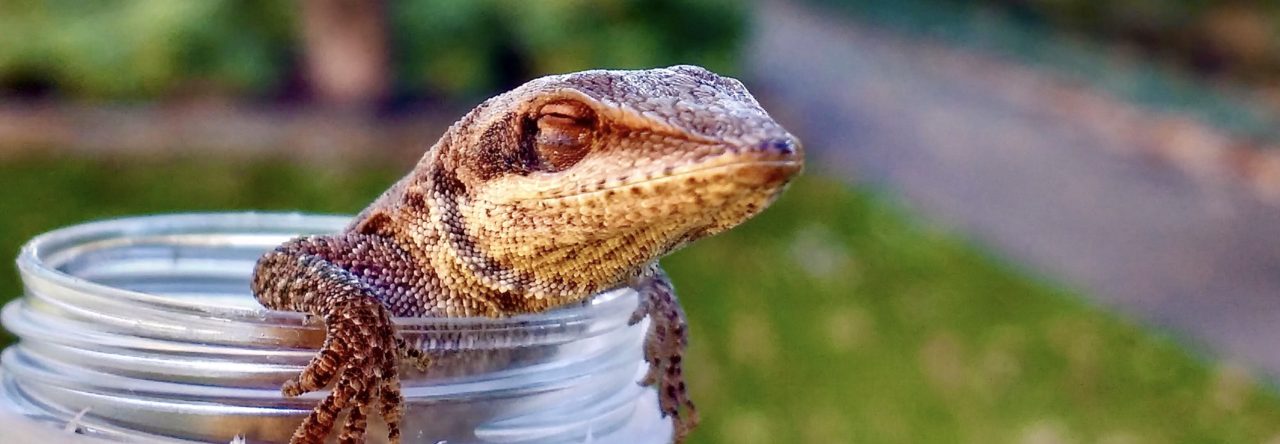Not effective at a great distance
Think about when you want to communicate with someone, but first you have to get their attention. Let’s start with verbal communication. If Fred is across the room, you probably holler out “Hey Fred” a lot louder than if he’s sitting next to you. Now, suppose you’re the non-verbal sort. If Fred’s a long distance away, you’re going to have to wave your hand wildly, maybe even jump up and down, to get his attention. But if he’s nearby, a little wave, even a discreet hand gesture, will suffice. Why we don’t whisper or make slight movements to attract the attention of those far away is pretty obvious–the target won’t hear or see you. But why not yell loudly or gesture emphatically even when the target is nearby (ok, we all know some annoying people who do this, but mostly people don’t)?
 Signal modulation is an area of great interest in the field of animal communication, and Steinberg and Leal have just published a fascinating study on the Puerto Rican A. gundlachi in Animal Behaviour (pdf). The key to understanding signal modulation is to investigate how signal detectability changes as a function of distance. Building on prior work by Fleishman on A. sagrei, Steinberg and Leal conducted lab studies in which they move a black disk against white paper to determine how much movement is needed to attract the lizard’s attention. Fortunately, this can be easily done with lizards because they have something called the visual grasp reflex–when something gets their attention, they shift their eye to gaze right at it. Easy to determine in the lab. So, by moving the disk up-and-down different amounts and varying the distance of the lizard, the authors were able to determine the degree of amplitude of movement in the visual field most detectable by the lizards (see figure on right). Notably, there is not only a minimum visual angle, but also a maximal one, above which response declines (and then increases again; for reasons discussed in the paper, Steinberg and Leal focus on the maximal peak in the 0.25-0.75 degree range).
Signal modulation is an area of great interest in the field of animal communication, and Steinberg and Leal have just published a fascinating study on the Puerto Rican A. gundlachi in Animal Behaviour (pdf). The key to understanding signal modulation is to investigate how signal detectability changes as a function of distance. Building on prior work by Fleishman on A. sagrei, Steinberg and Leal conducted lab studies in which they move a black disk against white paper to determine how much movement is needed to attract the lizard’s attention. Fortunately, this can be easily done with lizards because they have something called the visual grasp reflex–when something gets their attention, they shift their eye to gaze right at it. Easy to determine in the lab. So, by moving the disk up-and-down different amounts and varying the distance of the lizard, the authors were able to determine the degree of amplitude of movement in the visual field most detectable by the lizards (see figure on right). Notably, there is not only a minimum visual angle, but also a maximal one, above which response declines (and then increases again; for reasons discussed in the paper, Steinberg and Leal focus on the maximal peak in the 0.25-0.75 degree range).
Of course, because the movement is expressed as an angle relative to the visual field, then as the distance to the target receiver increases, larger amplitude movements would be necessary to be detected. Moreover, looked at the other way, because there may be a degree of movement too great to maximally stimulate a response, the amplitude would be expected to decrease at shorter distances.

Field apparatus. Photo from Chipojolab‘s description of their paper.
And that is exactly what Steinberg and Leal found in a field experiment. When they presented focal anoles with a second anole at various distances, the amplitude of display varied as a function of distance, and most displays had an amplitude in the range that was predicted to be maximally detectable.
Beyond illustrating that anoles do, indeed, modulate their displays to enhance detectability by the recipient, the paper has several interesting further conclusions. First, the results explain why lizards don’t give high-amplitude displays at close quarters. Although saving energy and avoiding drawing the attention of predators may also be important, it turns out that large amplitude displays may not be effective at gaining attention of nearby lizards.
Second, the results also imply that anoles can judge the distance to another lizard. How they do this is unknown.
Lastly, third, the authors comment on recent studies that argue that anoles adjust the speed of their displays to be more detectable against background environmental movement. They argue that, in fact, what is being adjusted is not speed, but amplitude of the headbob, and that given the limitations of videos used in previous studies, the two phenomena may not be distinguishable.
For another perspective and more details on this study, see the author’s own report over at Chipojolab.
- Evolution in Real Time on Lizard Island - March 23, 2025
- Spider Snags Adult Anolis osa - March 22, 2025
- An Homage to the Green Anoles of New Orleans - March 21, 2025



Leave a Reply